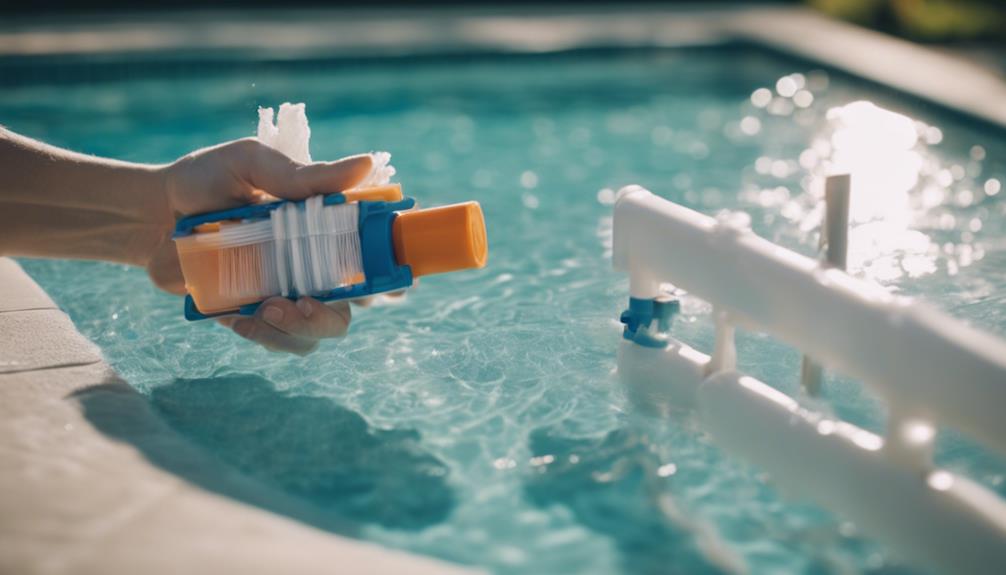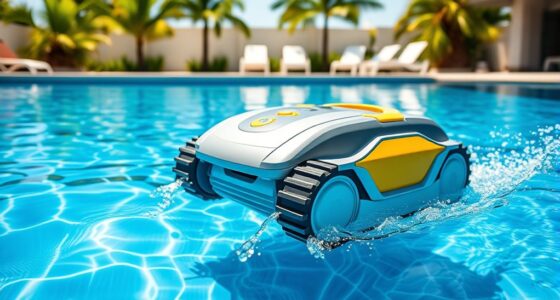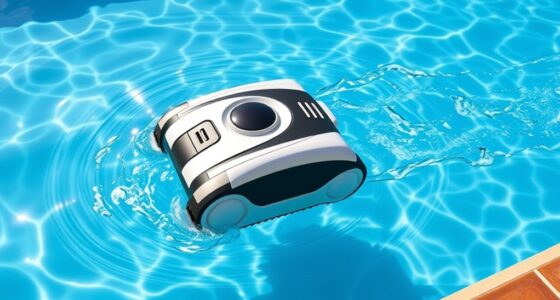To properly maintain a saltwater swimming pool, it is important to use 99% pure pool-grade salt and keep salinity levels between 2,700-3,400 PPM. Running the pool pump for a minimum of 8 hours each day is essential for proper circulation, which helps prevent debris buildup, algae growth, and ensures an even distribution of salt and chlorine. Balancing pH levels is crucial to prevent calcium buildup, and regular cleaning of the salt cell is necessary to maintain chlorine production. Monitoring pH levels (7.2-7.6) and free chlorine levels (1-3 ppm) is important for a safe swimming environment. Additionally, shocking the pool weekly and conducting regular cleaning and water quality testing are necessary to prevent any issues. By following these steps consistently, you can ensure the best maintenance for your pool.
Key Takeaways
- Use pool-grade salt with at least 99% purity to maintain salinity levels.
- Ensure proper water circulation by running the pump and filter for 8 hours daily.
- Prevent calcium buildup by maintaining pH levels and testing calcium hardness.
- Regularly clean the salt cell every 3 months to avoid water quality issues.
- Maintain balanced pH and chlorine levels through weekly testing and adjustments.
Proper Salt Addition
To properly maintain your saltwater pool, make sure you use pool-grade salt that's at least 99% pure when adding salt to the water. Maintaining the correct salt levels is essential for the best performance of your pool, with the recommended salinity level falling between 2,700 to 3,400 parts per million (PPM).
When adding salt, guarantee proper distribution by turning on the pool filter system to circulate the salt for 24 hours. This step is important to achieve thorough mixing and prevent localized high concentrations of salt.
To accurately monitor the salt levels, use a digital salinity tester to check various areas of the pool, ensuring uniformity. Regularly testing and adjusting salt levels around the pool is crucial to maintain water quality and prevent any potential issues that may arise from inconsistent salinity levels.
Maintaining Water Circulation
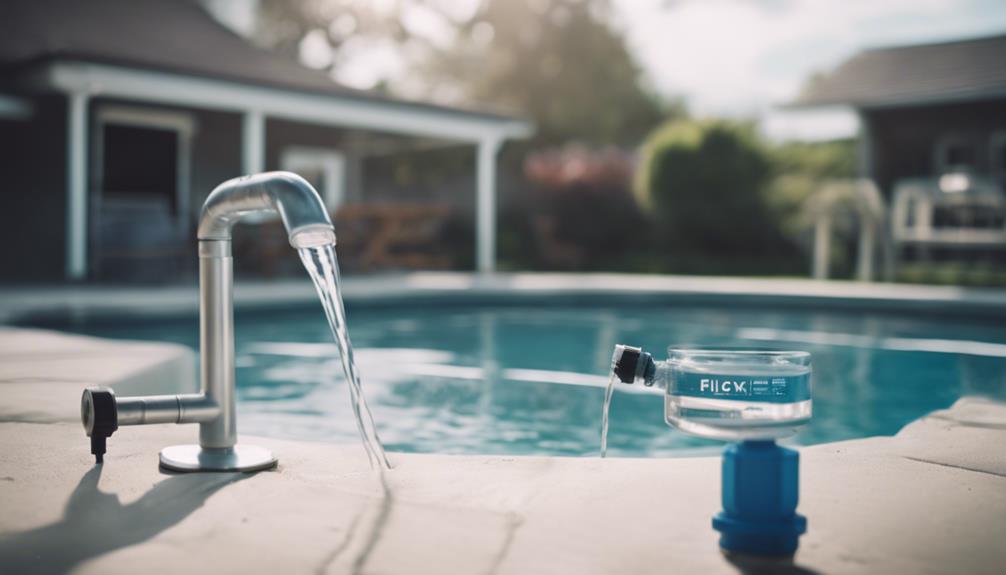
For peak water quality and pool cleanliness, make sure you run the pool pump and filter for a minimum of 8 hours daily to maintain proper circulation in your saltwater pool.
Adequate water circulation is vital for evenly distributing salt and chlorine throughout the pool, which is essential for effective sanitation. By ensuring proper water circulation, you can prevent the buildup of dirt and debris, thereby contributing to the overall cleanliness of your pool.
Additionally, consistent circulation helps maintain balanced water chemistry by evenly dispersing chemicals, creating a safe swimming environment for you and your family.
Stagnant areas in the pool are minimized through continuous water circulation, reducing the risk of algae growth and other water quality issues.
Preventing Calcium Buildup
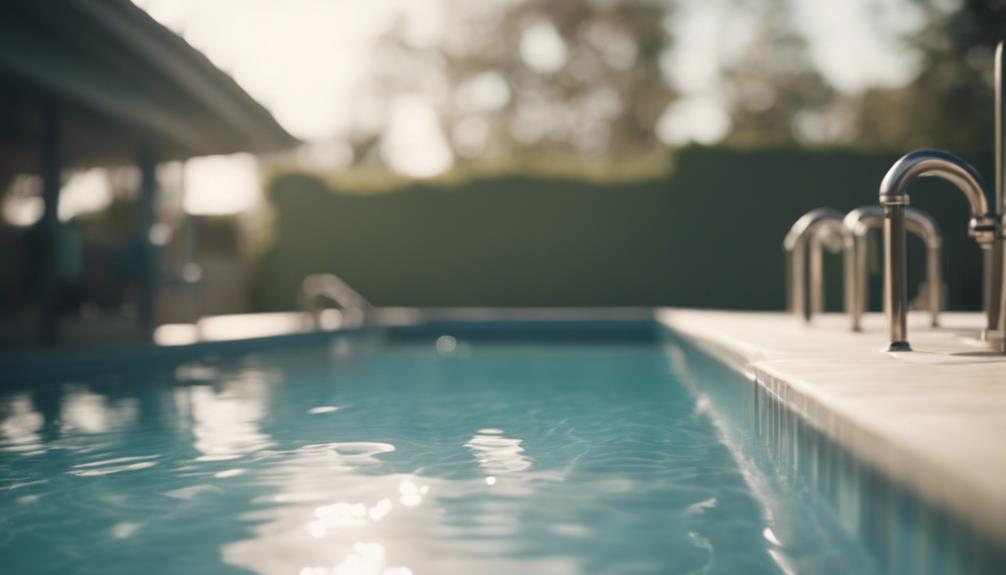
Maintain proper pH levels to prevent calcium buildup around your pool and avoid scaling and corrosion.
Calcium buildup occurs when the water becomes oversaturated with calcium, leading to the formation of scaling on pool surfaces. To prevent this, it's important to monitor and regulate the pH levels in your pool regularly.
Imbalanced pH levels can contribute to the precipitation of calcium, resulting in unsightly deposits that are challenging to remove. Additionally, maintaining proper water chemistry is vital in preventing calcium buildup.
By routinely testing and adjusting the calcium hardness levels in your pool, you can avoid excessive accumulation of calcium that can lead to scaling issues. Using a calcium remover or a mild acid solution can help dissolve existing calcium deposits and prevent new buildup.
Checking Salt Cell Cleanliness
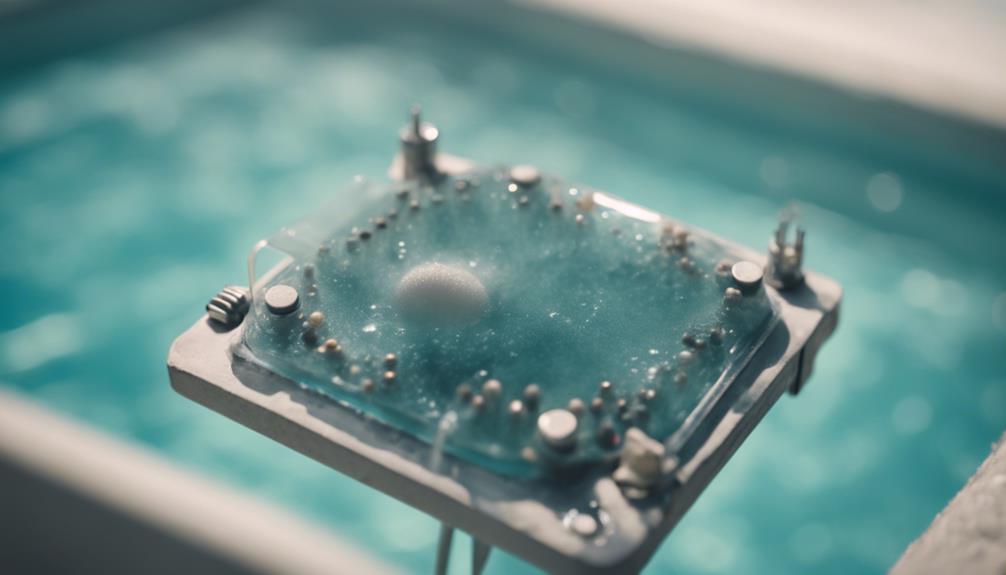
When it comes to maintaining your saltwater pool, checking the cleanliness of your salt cell is essential. Regularly inspecting the salt cell every 3 months can help prevent scale buildup and guarantee efficient chlorine generation.
Use a high-pressure hose or consider a mild acid wash to clean out any deposits that may hinder its performance.
Salt Cell Inspection
Regularly inspecting the salt cell every 3 months for calcium buildup or scale deposits is essential for maintaining the efficiency of your salt chlorinator system. When you inspect the salt cell, keep an eye out for any signs of white deposits or flakey spots on the surface. These can indicate the presence of calcium buildup or scale deposits, which can hinder the proper functioning of your salt chlorinator. By catching these issues early through regular inspections, you can guarantee that your salt cell continues to operate effectively.
Inspecting the salt cell is a simple yet important step in your pool maintenance routine. If you notice any buildup or deposits, you can then proceed to clean the salt cell using a high-pressure hose or a mild acid solution. Following the manufacturer's instructions for cleaning is crucial to prevent damage to the salt cell.
Cleaning Process
Check the cleanliness of your salt cell regularly to guarantee maximum chlorine production and prevent maintenance issues. Scale buildup on the salt cell can impede chlorine production, leading to water quality problems.
Inspect the salt cell every three months for any deposits or scaling. If you notice buildup, use a high-pressure hose or a mild acid solution to clean the cell thoroughly.
Proper maintenance of the salt cell is essential for efficient chlorine production and to extend the life of the cell. Neglecting to clean the salt cell can result in decreased chlorine levels, potentially causing algae growth or other water quality issues.
Following the manufacturer's guidelines for cleaning the salt cell is vital to ensure safe and effective maintenance. Remember to wear appropriate protective gear, such as gloves and goggles, when handling chemicals during the cleaning process.
Balancing Ph and Chlorine Levels
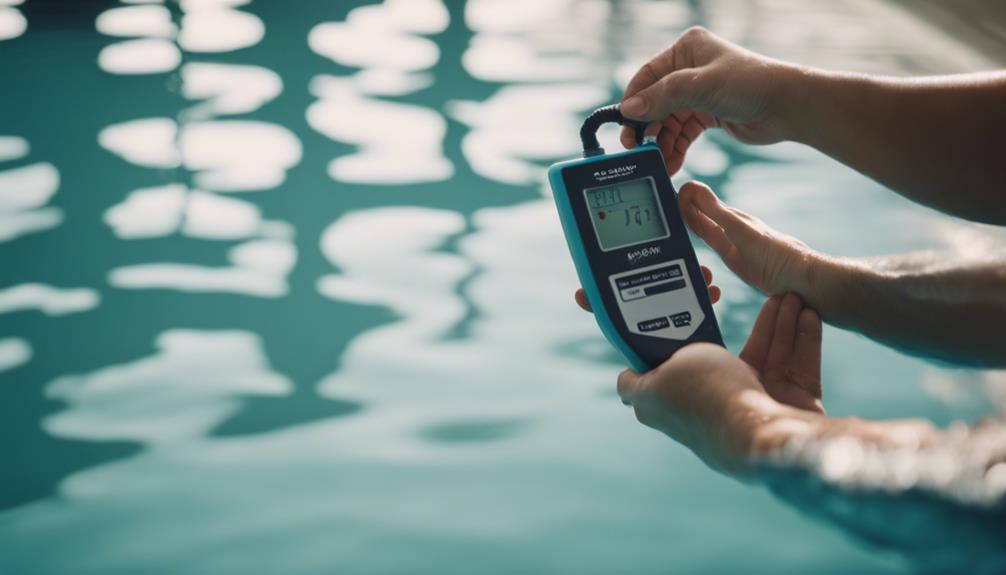
Maintaining the appropriate pH levels between 7.2-7.6 is essential to prevent skin and eye irritation in your saltwater pool.
Monitoring free chlorine levels at 1-3 ppm is vital for effective sanitation and algae prevention.
Properly balancing your pool's chemistry by adjusting chlorine and pH levels through regular testing ensures a safe and comfortable swimming environment for you and your guests.
Ph Level Importance
Properly balancing the pH and chlorine levels in your saltwater pool is essential for maintaining water clarity and sanitation. pH balance, ranging from 7.2 to 7.6, is vital for the effectiveness of free chlorine levels in your pool.
When pH levels are imbalanced, it can lead to poor chlorine performance, potentially causing algae growth and jeopardizing water quality. Regularly testing and adjusting pH levels is key to ensuring that your pool remains clean and safe for swimming.
High pH levels can reduce chlorine's effectiveness, requiring more chemicals and increasing maintenance costs. By monitoring and maintaining the correct pH levels in your saltwater pool, you not only promote efficient chlorine function but also guarantee a safe and enjoyable swimming experience for everyone.
Chlorine Level Monitoring
To maintain ideal sanitation and water quality in your saltwater pool, consistent monitoring of chlorine levels is essential for guaranteeing a safe and enjoyable swimming environment. Keeping the chlorine levels within the recommended range of 1-3 parts per million (ppm) is critical to effectively sanitize the pool water.
Additionally, balancing pH levels between 7.2-7.6 is essential to prevent skin and eye irritation and to ensure the effectiveness of chlorine in keeping your pool clean. Remember to adjust the chlorine output as needed based on regular test results to maintain a healthy swimming environment.
Properly balanced pH and chlorine levels are the key to a pleasant and safe swimming experience in your saltwater pool.
- Regularly test and monitor chlorine levels.
- Maintain chlorine levels between 1-3 ppm.
- Balance pH levels between 7.2-7.6.
- Adjust chlorine output based on test results.
- Ensure proper pH and chlorine levels for a healthy swimming experience.
Balancing Pool Chemistry
Regularly testing and adjusting pH and chlorine levels in your saltwater pool is essential for maintaining water balance and sanitation. pH levels should be tested weekly, aiming for a range of 7.2-7.6 to maintain proper water balance.
Monitoring and adjusting free chlorine levels between 1-3 ppm is important for effective sanitation. Utilize baking soda to raise pH levels and sodium carbonate or muriatic acid to lower them as needed.
Maintaining appropriate chlorine levels not only prevents algae growth but also ensures the safety of the water. Balancing pH and chlorine levels is crucial to prevent equipment corrosion and maintain high water quality standards.
Weekly Pool Shocking

To maintain your saltwater pool effectively, make sure to shock it weekly with a high dose of chlorine to eliminate bacteria, algae, and contaminants. This weekly shocking routine is essential for maintaining water clarity and sanitation in your saltwater pool.
Factors such as heavy pool use, high temperatures, and rainfall can increase the need for weekly shocking to keep the water clean and safe for swimming. When selecting a shock treatment, opt for a non-chlorine shock specifically designed for saltwater pools to prevent damage to the system.
Regular pool shocking not only kills bacteria and algae but also helps prevent common issues like cloudy water, algae growth, and unpleasant odors. By incorporating weekly shocking into your pool maintenance routine, you can ensure that your saltwater pool remains an invigorating and enjoyable oasis for you and your family to relax and swim in.
Skimming, Brushing, Vacuuming
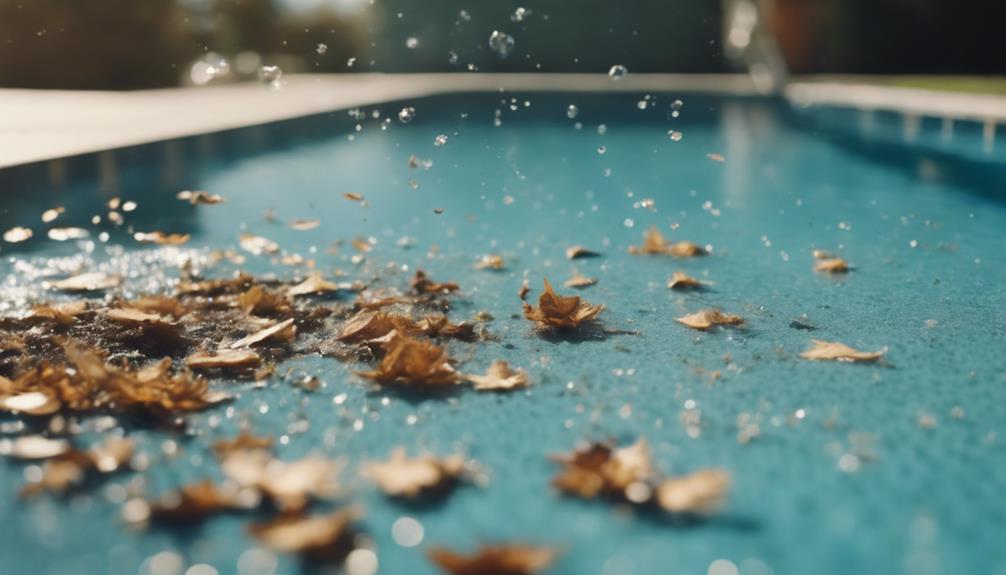
Maintaining a clean and clear saltwater pool involves daily skimming to remove debris and prevent buildup in the water. By skimming the pool surface regularly, you can prevent leaves, bugs, and other debris from sinking to the bottom and causing water quality issues.
Additionally, brushing the pool walls and floor on a weekly basis is important to prevent algae growth and maintain overall cleanliness. Algae can quickly spread in neglected areas, leading to cloudy and uninviting water.
Moreover, vacuuming the pool at least once a week is essential to remove dirt, leaves, and other debris that may have settled on the bottom. These routine maintenance tasks, including skimming, brushing, and vacuuming, play a significant role in keeping your saltwater pool crystal clear and reducing the need for excessive chemical treatments.
Regular Water Quality Testing
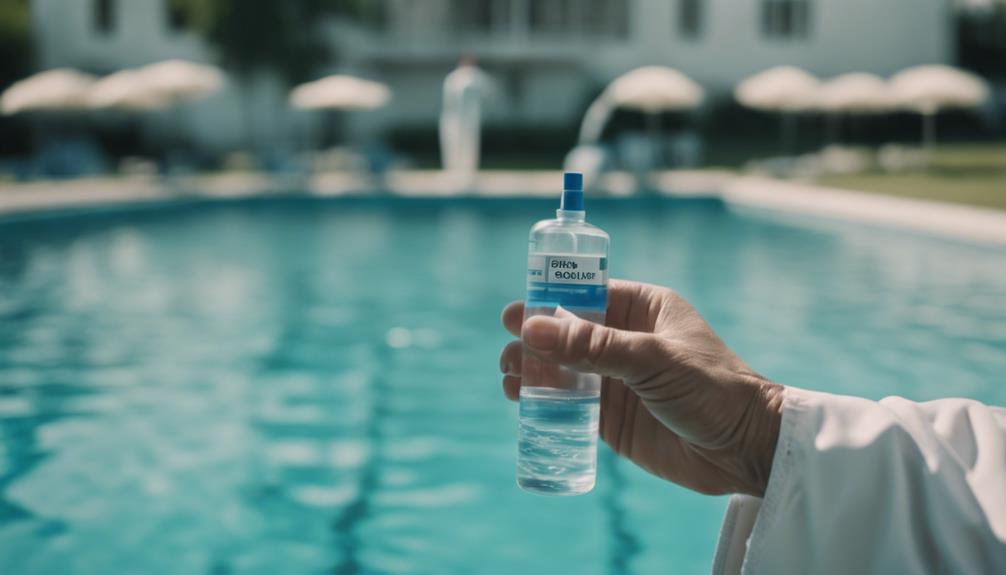
Guarantee proper sanitation and safety for swimmers by testing the free chlorine levels weekly in your saltwater pool.
Monitoring pH levels is also vital, especially considering the naturally high pH in saltwater systems. To maintain ideal water quality and prevent issues, it's vital to balance both pH and chlorine levels.
Additionally, testing alkalinity, stabilizer, and calcium levels monthly is key to ensuring a well-balanced pool environment. Aim to keep alkalinity levels between 100 and 150 parts per million (PPM) for the best pool water chemistry.
- Test chlorine levels weekly: Ensures safe swimming conditions.
- Monitor pH levels regularly: Prevents imbalances that can lead to skin and eye irritation.
- Balance pH and chlorine levels: Maintains water quality and prevents algae growth.
- Test alkalinity, stabilizer, and calcium levels monthly: Ensures a well-balanced pool chemistry.
- Maintain alkalinity between 100 and 150 PPM: Best for pool water chemistry.
Troubleshooting Common Issues
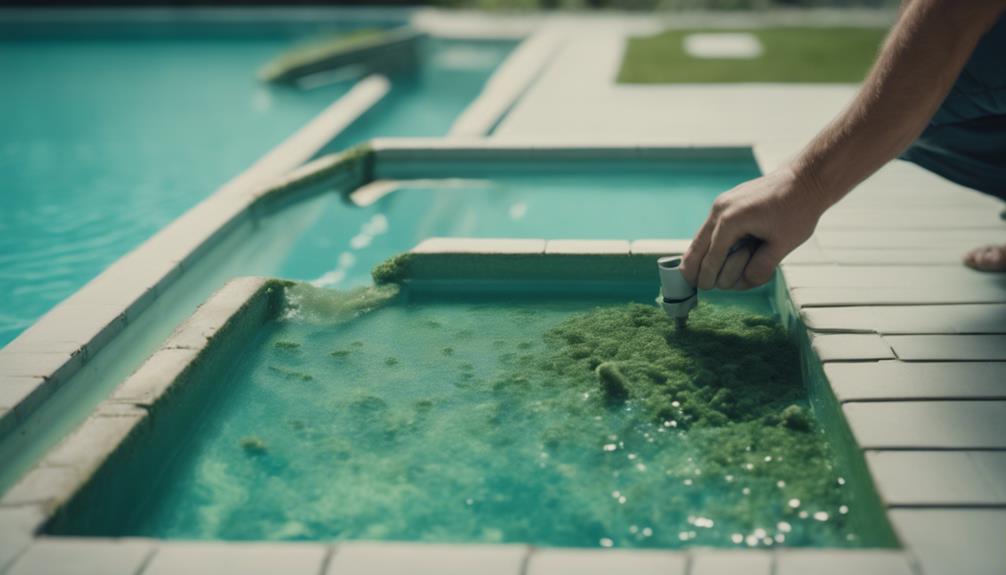
Troubleshoot common issues in your saltwater pool by identifying and addressing factors contributing to cloudy water, algae growth, and corrosion. Cloudy water often indicates a chlorine deficiency or a poorly functioning filtration system. To combat algae growth, ensure proper chlorine levels are maintained and run the pool pump regularly. Corrosion problems can arise from high salt levels, requiring diligent monitoring and dilution of concentrations. Regularly testing pH, alkalinity, and salt levels is crucial in troubleshooting and preventing common saltwater pool issues. By staying on top of maintenance tasks and testing water quality consistently, you can detect and address water quality problems early, ensuring a safe swimming environment for you and your family.
—
| Common Issue | Causes | Solutions |
|---|---|---|
| Cloudy Water | Chlorine deficiency, poor filtration | Test and adjust chlorine levels, check filtration system |
| Algae Growth | Insufficient chlorine, lack of regular pump operation | Maintain proper chlorine levels, run pump regularly |
| Corrosion Issues | High salt levels | Monitor, dilute salt concentrations as needed |
Converting to Saltwater Pool
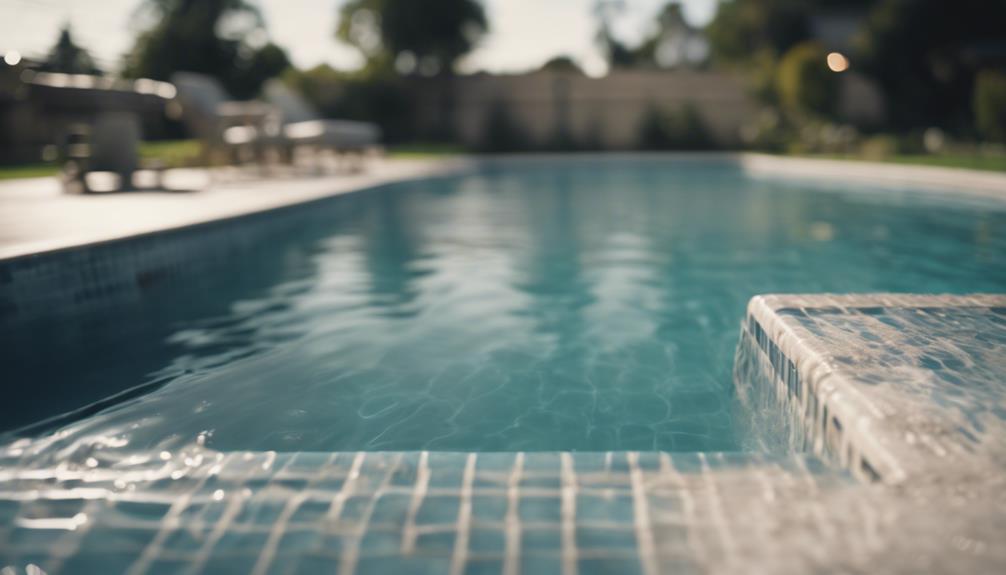
To successfully convert your traditional pool into a saltwater pool, start by purchasing a saltwater chlorinator system designed for your specific pool size and requirements.
Ensure a smooth changeover by following these steps:
- Drain and Clean: Prepare your pool by draining and cleaning it thoroughly before installing the saltwater system to guarantee peak performance.
- Add Salt: Follow manufacturer instructions and add the correct amount of pool-grade salt based on your pool's size to achieve the desired salinity.
- Test pH Levels: Regularly test and adjust pH levels after the conversion to maintain proper water balance and comfort for swimmers.
- Secure Connections: Before activating the saltwater system, verify that all connections are secure to prevent potential leaks or malfunctions that could impact the conversion process.
- Maintenance: Stay proactive with regular upkeep and monitoring to keep your saltwater pool in top-notch condition for long-term enjoyment.
Frequently Asked Questions
What Is Routine Maintenance for a Salt Water Pool?
Routine maintenance for a saltwater pool involves weekly tasks such as pH level testing and adjustment, and regular monitoring and adjustment of free chlorine levels for sanitation.
Maintaining the correct salinity level of 2,700 to 3,400 PPM is essential for pool health. Cleaning and inspecting the salt cell every 3 months ensures ideal chlorine generation.
Additionally, weekly tasks like skimming, brushing, and vacuuming help keep the water clear and free of debris.
Is It Difficult to Maintain a Saltwater Pool?
Maintaining a saltwater pool is generally easier than a traditional chlorinated pool due to the self-regulating nature of salt chlorination systems. The process requires less monitoring and adjustment of chlorine levels, reducing maintenance efforts.
While initial setup costs may be higher, long-term maintenance expenses are often lower. Regular testing of salt levels and water chemistry, along with cleaning the salt chlorinator cell, are key tasks for proper upkeep.
Soft, gentle water and reduced skin and eye irritation are benefits of well-maintained saltwater pools.
Do You Need to Add Chemicals to a Saltwater Pool?
Yes, you need to add chemicals to a saltwater pool.
Despite the misconception that saltwater pools are maintenance-free, you still require regular monitoring and adjustment of pH, alkalinity, stabilizer levels, and occasional additions of muriatic acid, shock treatment, or algaecides.
Testing for free chlorine and salt levels is vital for water quality.
While saltwater pools generate chlorine, supplemental chemicals are essential for balance and safe swimming conditions.
How Often Should I Add Salt to a Salt Water Pool?
You should add salt to your saltwater pool when levels fall below the recommended range of 2,700 to 3,400 parts per million (PPM).
Factors like heavy rain, splash out, or dilution from adding fresh water can lower salt levels. Use a digital salinity tester to measure salt levels accurately in various pool areas.
Adding salt after rain or water addition helps maintain ideal salinity for efficient chlorine generation. Remember to turn off the chlorine generator while adding salt for proper distribution and functionality.
What Changes in Saltwater Pool Maintenance are Needed During the Rainy Season?
During the rainy season, pool maintenance becomes even more important to prevent algae and bacteria buildup. To keep your saltwater pool in top condition, consider these rainy season pool maintenance tips. Regularly check and adjust the pH levels, ensure proper filtration, and use algaecide as a preventive measure.
Conclusion
In summary, maintaining a saltwater pool doesn't have to be a challenging task. By following the proper care and maintenance steps outlined in this article, you can guarantee your pool stays clean, safe, and enjoyable for all swimmers.
Remember, a little effort goes a long way in keeping your saltwater pool in top condition. So don't let misinformation deter you – with the right knowledge and approach, you can easily care for your saltwater swimming pool like a pro.

